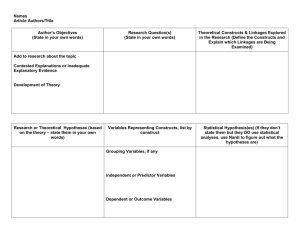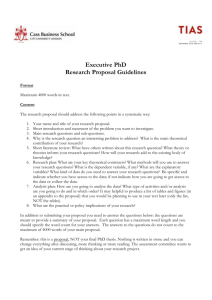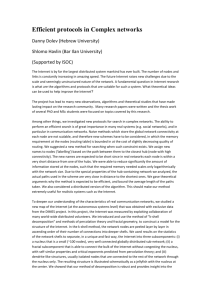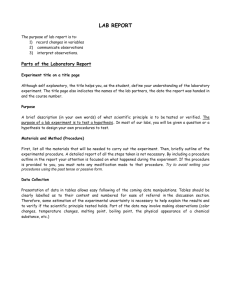SIKS BASIC COURSE RESEARCH METHODS Assignments
advertisement
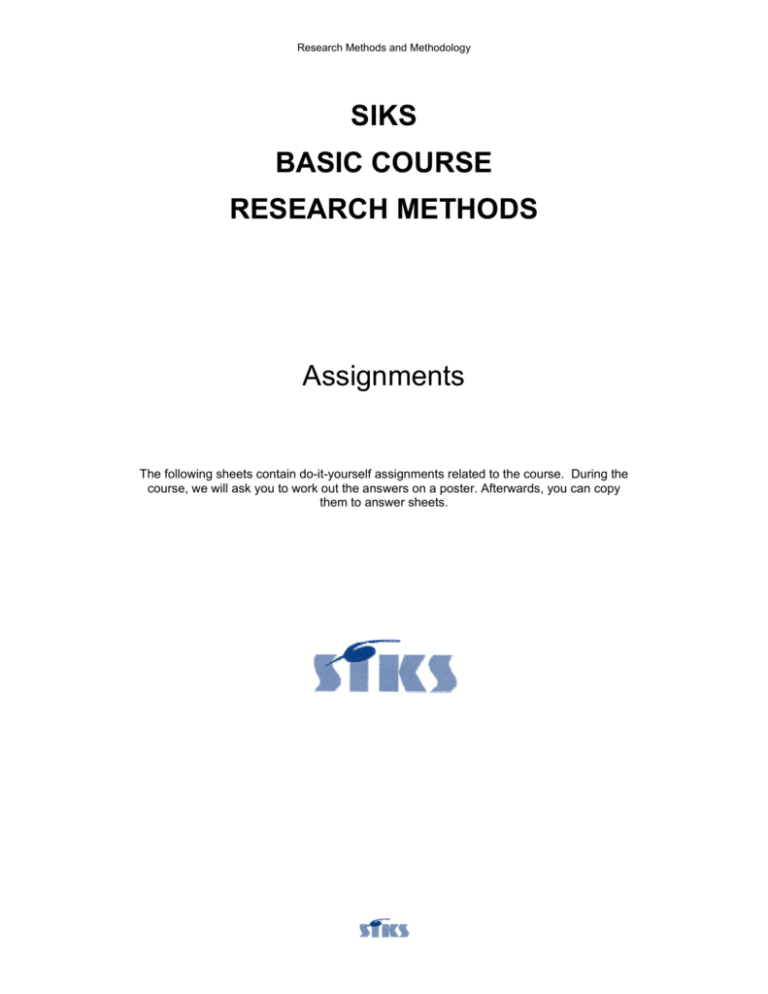
Research Methods and Methodology SIKS BASIC COURSE RESEARCH METHODS Assignments The following sheets contain do-it-yourself assignments related to the course. During the course, we will ask you to work out the answers on a poster. Afterwards, you can copy them to answer sheets. Research Methods and Methodology Assignment 0 (preparational) Background: Wieringa, R.& H. Heerkens, Evaluating the structure of research papers: a Case Study," 2nd International Workshop on Comparative Evaluation in Requirements Engineering, Sydney, Australia: Faculty of Information Technology, University of Technology, Sydney, 2004, pp. 41-50. 0.1. Is there a world problem (sometimes called action problem) that your research is addressing? If so (there usually is!), describe what is the problem, who are the stakeholders and what are the most important norms in the problem situation 0.2. What is the central knowledge problem that your research is addressing? Work it out in specific research questions that you want to answer. For each research question, try to indicate your research method (HOW you want to find an answer) 0.3. Describe the objective of your research. a. If you do have a world problem, then characterize the general research objective in terms of how it addresses the world problem (diagnosis of the problem, identifying the requirements, the design of a new solution, evaluation of a solution – one of these, or more than one). b. Describe you research objective in one sentence with the following structure: "The objective is to <your contribution, the value of what you do> by <what you do>" Example: “The objective is to enable the monitoring of electronic contracts by designing, verifying and testing a temporal logic formula checking algorithm" 0.4. Describe the theoretical relevance of your research. a. What are the theories or frameworks that you start with? b. Describe the theoretical relevance in one sentence with the following structure: "The theoretical relevance of the research is that it <explores|extends|evaluates|..> <theory> by <what you do>" Example: "The theoretical relevance of the research is that is extends the agent society framework of Dellarocas by providing a contract language and its logical semantics" or "The theoretical relevance of the research is that it evaluates Nolan's IT evolution theory by testing its predictions in a group of recent Dutch start-ups" In both 3 and 4, you may use more than one sentence if you can identify more than one independent objective or independent theoretical contribution Research Methods and Methodology Assignment 1: conceptual design Background: course sheets “Concept definition”, Hans Weigand 1.1 Write down 3-7 key concepts from your research object (more underlying concepts can be added during the steps below, if necessary). These can be entity like (e.g. negotiation support system) or phenomenal (e.g. search efficiency). 1.2 Draw an object model for the entity types that you recognize in your concept descriptions and their relationships. For the object model, you can use a simple ERnotation. 1.3 Identify constructs in need of further definition and unravel constructs by means of the notional grid. Constructs are phenomena that your research tries to optimize or relate; often not directly observable. Examples: “user-friendliness”, “maintenance costs”, “learning effort”. The notional grid has a tree-like structure and contains constructs, variables and indicators, where variables denote observable phenomena to a construct, and indicators are measurable operationalizations of the variables. Example: “user-friendliness” (construct), “interactivity” (variable), “”mean response time” (indicator) 1.4 Draw a conceptual framework linking your constructs, where links represent hypotheses about cause/effects. Annotate the links with + and – signs. 1.5 Write down stipulative definitions for the key concepts. Also identify synonyms, avoid homonyms. A stipulative definition is not an attempt at the best universal description of the concept, but says what definition you have decided to use in the context of your research. It is typically delineating your scope. Research Methods and Methodology Assignment 2: problem diagnosis Background: course sheets Wieringa The problem diagnosis can be seen as an elaboration of assignment 0.1. The goal is to explore the problem, find underlying causes and then solution directions. If the causes are not known yet, or hypothetical, this indicates possible knowledge problems to be worked out later. 2.1. Draw a problem bundle (a conceptual framework as in assignment 1.4) of the assumed causal relations in your world problem domain. 2.2. Mark with an asterisk those nodes in the diagram that you think could be influenced with the results of your project. If these nodes have no causes or no effects yet, then expand the diagram. 2.3. Draw a 3-column table, fill the left column with the core problems that you select from the controllable nodes in the problem bundle, and then fill in the other columns. | CORE PROBLEM | SOLUTION DIRECTION | VALIDATION METHOD | Research Methods and Methodology Assignment 3: solution design Background: course sheets Wieringa Develop a possible solution. If the information required is not known yet, or only hypothetical, this indicates possible knowledge problems to be worked out later. 3.1 Draw a solution system (a conceptual framework as in assignment 1.4) of the assumed causal relations in the solution domain. At the right hand side, we find nodes without outgoing arcs; these nodes typically correspond to the core problems identified in 2.3. The solution and solution components – there may be several alternatives - are at the left. Also add assumed side-effects of certain solutions (you might use different colours for nodes that refer to a solution and nodes that refer to an effect) 3.2 Draw a taxonomy tree of the solution alternatives (one tree for each core problem). For example, if the goal is “information sharing”, this goal can be put at the top; then a difference can be made between centralized and decentralized solutions; decentralized solutions can be divided into etc. The tree that you draw now does not need to be complete, but it should at least be expanded to the specific solution direction(s) that you have in mind for further exploration. Research Methods and Methodology Assignment 4: identification of knowledge problems 4.1 List the knowledge problems that you can identify in the results of Assignment 1-3. Examples are the validation of an assumed causal relationship in the problem domain, or the performance comparison of two solution alternatives in the solution domain, or the (open) question what solution directions exist in the literature. Express each of them in the form of a research question and give them a number. 4.2 For which research questions do you need to do research? For each of these, answer the following questions – What research method(s) are you going to use? – Why will this give you the desired knowledge? (justification of the choice) – How reliable is that knowledge?
